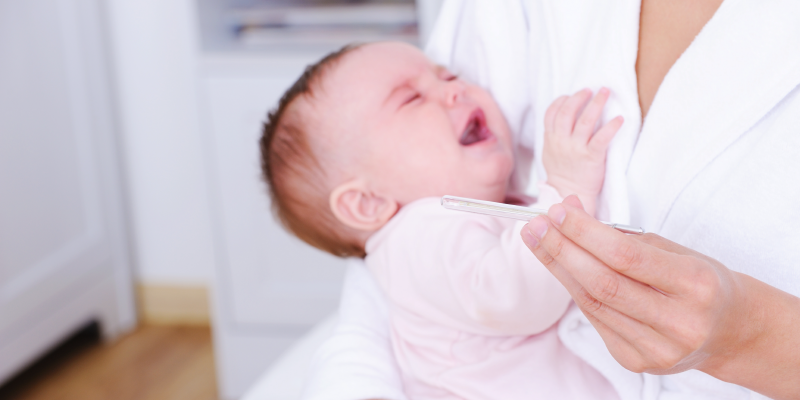
What You Really Need to Know About RSV
As a parent, there is no worse feeling than when your baby is sick. Newborns and infants carry the worst risk since it takes awhile for their immune systems to be fully developed and able to fight off a virus. Respiratory syncytial virus, commonly known as RSV, is a highly contagious virus that affects the lungs and respiratory system. The bad news is that it’s extremely common for children; almost every child is exposed to RSV before he even turns two. For most children, RSV never turns into anything more than the common cold, but some children can get very sick. While RSV can lead to serious complications such as pneumonia or worse, there are some things you can do to prevent your child from getting RSV. Here’s what you really need to know about RSV, including the symptoms, prevention and treatment.
What is RSV?
RSV (respiratory syncytial virus) is an illness of the nose, throat and lungs. It usually flares up between late fall and early spring months. For more children, RSV causes a cold and can last anywhere from five to seven days. Some babies carry a greater risk of getting RSV, especially younger infants, preemies, babies with heart defects, those with a chronic lung disease and/or weakened immune systems due to illness or treatments. The way your doctor diagnoses RSV is by doing a physical exam, which may include a nasal swab test. Chest X-rays and/or oxygen saturation tests may also reveal lung congestion. In most cases, these tests aren’t necessary because RSV is not serious enough to warrant the further testing. As with the common cold, RSV is contagious and can be spread through direct person-to-person contact with saliva, mucus or nasal discharge, unclean hands (it can survive 30 minutes or more on unwashed hands) and unclean objects or surfaces (it can survive up to six hours on surfaces, toys, keyboards, door knobs, etc.)
These are common RSV symptoms
It’s possible that people with RSV may not show any obvious signs of the infection. If they do appear, it’s usually four to six days after they’ve been exposed and can last up to two weeks. However, there are symptoms to watch for in babies, which include: shortness of breath, wheezing, irritability, lethargy, cough, runny nose, fever (temperature of 100.4 or higher) and poor feeding. There is no cure for RSV and medications, like steroids and antibiotics, do not help as it’s a virus that generally need to take its course. For most children, RSV symptoms start going away and they are able to recover from the infection on their own.
When to worry, signs of a complication
RSV is typically more dangerous with babies, and according to the Centers for Disease Control and Prevention (CDC), about one to two percent of babies with RSV get admitted to the hospital. And then the odds of landing in the ICU go up. Statistics show that about 100 babies in America die from RSV each year. If that thought scares you, it shouldn’t. There are warning signs you can watch for that will alert you to call the pediatrician right away. A cold that isn’t healing on its own can develop into bronchiolitis, which may include symptoms such as fast breathing, flaring of the nostrils, head bobbing while breathing, rhythmic grunting during breathing, belly breathing, tugging between their ribs or lower neck and wheezing. If it seems as though your baby is really working hard to breathe, it could be a sign that the RSV has moved into bronchiolitis. Watch your baby’s breathing, does his rib cage cave in? Does the breathing form an upside down “V” shape under his neck? This is a sign he is working too hard to breathe.
Also, if your child has any of these other symptoms, it could be cause for concern: symptoms of bronchiolitis, dehydration (fewer than one wet diaper every eight hours), difficulty breathing, gray or blue color to his tongue, lips or skin and a significant decrease in activity and alertness. All of these are reasons to worry and you should call your pediatrician right away if your baby is exhibiting these symptoms.
How you can protect children from RSV
You can sigh a relief knowing that only three percent of all children (three out of 100) will end up in the hospital because of RSV. It’s rare for a child to be admitted to the pediatric intensive care unit (PICU). So is there anything you can do to help prevent RSV in the first place? Yes! As with any kind of illness, the best way to keep it at bay is to wash your hands often and for at least 20 seconds. If possible, limit your baby’s exposure to anyone with colds. If it means keeping him away from day care or your other children, it’s best to try and avoid everyone getting sick at once. Disinfect objects and surfaces in your home regularly to avoid carrying excessive germs. And finally, consider breastfeeding your baby if you’re able to. Breast milk contains unique antibodies that can help prevent and fight infections.
The bottom line is that most children recover well from RSV and it doesn’t become a lingering concern for parents. But as with all things health and wellness, it’s better to be armed with information on prevention and what to do now so that you can proceed accordingly if you ever are in a situation where RSV has turned dangerous.
Join the other 100,000+ new parents who love Bitsy Boxes.

